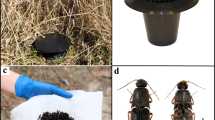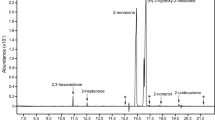Abstract
Elater ferrugineus is a threatened click beetle inhabiting old hollow trees. Its larvae consume larvae of other saproxylic insects including the threatened scarab beetle Osmoderma eremita. Recently, (R)-(+)-γ-decalactone was identified as a male-produced sex pheromone of O. eremita. Here we present evidence that E. ferrugineus adults use this odor as a kairomone for location of their prey. In field trapping experiments, significantly more trapping events of E. ferrugineus beetles were observed in Lindgren funnel traps baited with (R)-(+)-γ-decalactone than in control traps (20 vs. 1, respectively). Analyses of headspace collections from E. ferrugineus beetles indicate that the predator itself does not produce the substance. Both sexes were attracted to the prey pheromone, suggesting that E. ferrugineus males use the odor as an indirect cue for location of mates or of the tree hollows, which make up their habitat. When compared to pitfall traps, the Lindgren system was significantly more effective in trapping E. ferrugineus, and no difference could be established for O. eremita, showing the high potential to use odor-based systems to catch both species. We suggest that (R)-(+)-γ-decalactone could be used as a master signal in monitoring programs for these vulnerable beetle species, which are both regarded as indicators of the associated insect fauna of the threatened habitat of old hollow trees.
Similar content being viewed by others
REFERENCES
Aldrich, J. R. 1999. Predators, pp. 357–381, in J. Hardie and A. K. Minks (eds.). Pheromones of Non-Lepidopteran Insects Associated with Agricultural Plants. CAB International, New York.
Anonymous, 1992. Directive 92/43 of the Council of the European Community on the Conservation of Habitats and Wild Fauna and Flora. European Community, Brussels.
Bakke, A. and Kvamme, T. 1981. Kairomone response in Thanasimus predators to pheromone components of Ips typographus. J. Chem. Ecol. 7:305–312.
Borden, J. H. 1997. Disruption of semiochemical-mediated aggregation in bark beetles, pp. 421–438, in R. T. Cardé and A. K. Minks (eds.). Insect Pheromone Research: New Directions. Chapman and Hall, New York.
Borg-Karlsson, A.-K, Ågren, L., Dobson, H., and BergstrÖm, G. 1988. Identification and electroantennographic activity of sex-specific geranyl esters in an abdominal gland of female Agriotes obscurus (L.) and A. lineatus (L.) (Coleoptera, Elateridae). Experentia 44:531–534.
Dajoz, R. 2000. Insects and Forests. Intercept Publishing, London, pp. 515–533.
Eliasson, P. and Nilsson, S. G. 2002. “You should hate young oaks and young noblemen”: The environmental history of oaks in eighteenth-and nineteenth-century Sweden. Environ. Hist. 7:657–675.
Frazier, J. L., Nebecker, T. E., Mizell, R. F., and Calvert, W. H. 1981. Predatory behavior of the clerid beetle Thanasimus dubius (Coleoptera: Cleridae) on the southern pine beetle (Coleoptera: Scolytidae). Can. Entomol. 113:35–43.
Gärdenfors, U. (ed.) 2000. RÖdlistade arter i Sverige 2000 [The 2000 Red List of Swedish Species]. ArtDatabanken, Uppsala, Sweden.
Hannah, L., Carr, J. L., and Lankerani, A. 1995. Human disturbance and natural habitat: A biome level analysis of a global data set. Biodivers. Conserv. 4:128–155.
Hansen, V. 1966. Danmarks Fauna, Biller XXIII, Smældere of Pragtbiller. Gads Forlag, København, pp. 36–37 (in Danish).
Hedin, J. and Ranius, T. 2002. Using radio telemetry to study dispersal of the beetle Osmoderma eremita, an inhabitant of tree hollows. Comput. Electron. Agric. 35:171–180.
Larsson, M. C., Hedin, J., Svensson, G. P., Tolasch, T., and Francke, W. 2003. Characteristic odor of Osmoderma eremita identified as a male-released pheromone. J. Chem. Ecol. 29:575–587.
Luce, J.-M 1996. Osmoderma eremita (Scopoli 1763), pp. 64–69, in P. J. van Helsdingen, L. Willemse, and M. C. D. Speight (eds.). Background Information on Invertebrates of the Habitats Directive and the Bern Convention. Part 1: Crustacea, Coleoptera, and Lepidoptera. Council of Europe, Strasbourg, France.
Nilsson, S. G. 1997. Forests in the temperate-boreal transition: Natural and man-made features. Ecol. Bull. 46:61–71.
Nilsson, S. G. and Baranowski, R. 1994. Indicators of megatree continuity—Swedish distribution of click beetles (Coleoptera, Elateridae) dependent on hollow trees. Entomol. Tidskr. 115(3):81–97 (in Swedish, English summary).
Nilsson, S. G., Hedin, J., and Niklasson, M. 2001. Biodiversity and its assessment in boreal and nemoral forests. Scand. J. For. Res. 16 (Suppl. 3):10–26.
Palm, T. 1959. Die Holz-und Rinden-Käfer der Süd-und Mittelschwedishen Laubbäume. Lund, Sweden: Opuscula Entomologica supplementum XVI (in German, English summary).
Raffa, K. F. and Dahlsten, D. L. 1995. Differential responses among natural enemies and prey to bark beetle pheromones. Oecologia 102:17–23.
Ranius, T. 2001. Constancy and asynchrony of Osmoderma eremita populations in tree hollows. Oecologia 126:208–215.
Ranius, T. 2002a. Osmoderma eremita as an indicator of species richness of beetles in tree hollows. Biodivers. Conserv. 11:931–941.
Ranius, T. 2002b. Influence of stand size and quality of tree hollows on saproxylic beetles in Sweden. Biol. Conserv. 103:85–91.
Ranius, T. and Hedin, J. 2001. The dispersal rate of a beetle, Osmoderma eremita, living in tree hollows. Oecologia 126:363–370.
Ranius, T. and Nilsson, S. G. 1997. Habitat of Osmoderma eremita Scop. (Coleoptera: Scarabaeidae), a beetle living in hollow trees. J. Insect Conserv. 1:193–204.
Siegel, S. and Castellan, N. J. 1998. Nonparametric Statistics for the Behavioral Sciences, 2nd edn. McGraw-Hill, New York.
Svensson, G. P., Larsson, M. C., and Hedin, J. 2003. Air sampling of its pheromone to monitor the occurrence of Osmoderma eremita, a threatened beetle inhabiting hollow trees. J. Insect Conserv. 7:189–198.
Tóth, M., Furlan, L., Yatsynin, V. G., Ujváry, I., Szarukán, I., Imre, Z., Subchev, M., Tolasch, T., and Francke, W. 2002. Identification of sex pheromone composition of click beetle Agriotes brevis Candeze. J. Chem. Ecol. 28:1641–1652.
Weslien, J. 1994. Interaction within and between species at different densities of the bark beetle Ips typographus and its predator Thanasimus formicarius. Entomol. Exp. Appl. 71:133–143.
Wood, D. L. 1982. The role of pheromones, kairomones, and allomones in the host selection behavior of bark beetles. Annu. Rev. Entomol. 27:411–446.
Yatsynin, V. G., Rubanova, E. V., and Okhrimenko, N. V. 1996. Identification of female-produced sex pheromones and their geographical differences in pheromone gland extract composition from click beetles (Col., Elateridae). J. Appl. Entomol. 120:463–466.
Author information
Authors and Affiliations
Rights and permissions
About this article
Cite this article
Svensson, G.P., Larsson, M.C. & Hedin, J. Attraction of the Larval Predator Elater ferrugineus to the Sex Pheromone of Its Prey, Osmoderma eremita, and Its Implication for Conservation Biology. J Chem Ecol 30, 353–363 (2004). https://doi.org/10.1023/B:JOEC.0000017982.51642.8c
Issue Date:
DOI: https://doi.org/10.1023/B:JOEC.0000017982.51642.8c




